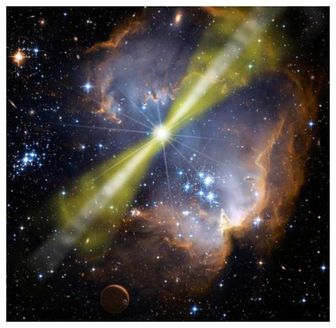
This artist’s impression shows a gamma-ray burst with two intense beams of relativistic matter emitted by the black hole.
Roughly once a day the sky is lit up by a mysterious torrent of energy. These events - known as gamma-ray bursts - represent the most powerful explosions in the cosmos, sending out as much energy in a fraction of a second as our Sun will give off during its entire lifespan.
Yet no one has ever witnessed a gamma-ray burst directly. Instead astronomers are left to study their fading light.
New research from an international team of astronomers has discovered a puzzling feature within one Gamma-ray burst, suggesting that these objects may behave differently than previously thought.
These powerful explosions are thought to be triggered when dying stars collapse into jet-spewing black holes. While this stage only lasts a few minutes, its afterglow - slowly fading emission that can be seen at all wavelengths (including visible light) - will last for a few days to weeks. It is from this afterglow that astronomers meticulously try to understand these enigmatic explosions.
The afterglow emission is formed when the jets collide with the material surrounding the dying star. They cause a shockwave, moving at high velocities, in which electrons are being accelerated to tremendous energies. However, this acceleration process is still poorly understood. The key is in detecting the afterglow's polarization - the fraction of light waves that move with a preferred plane of vibration.
"Different theories for electron acceleration and light emission within the afterglow all predict different levels of linear polarization, but theories all agreed that there should be no circular polarization in visible light," said lead author Klaas Wiersema in a press release. "This is where we came in: we decided to test this by carefully measuring both the linear and circular polarization of one afterglow, of GRB 121024A, detected by the Swift satellite."
And to their surprise, the team detected circular polarization, meaning that the light waves are moving together in a uniform, spiral motion as they travel. The gamma-ray burst was 1000 times more polarized than expected. "It is a very nice example of observations ruling out most of the existing theoretical predictions," said Wiersema. The detection shows that current theories need to be re-examined. Scientists expected any circular polarization to be washed out. The radiation of so many electrons travelings billions of light-years would erase any signal. But the new discovery suggests that there could be some sort of order in the way these electrons travel.
Of course the possibility remains that this particular afterglow was simply an oddball and not all afterglows behave like this.
Nonetheless "extreme shocks like the ones in GRB afterglows are great natural laboratories to push our understanding of physics beyond the ranges that can be explored in laboratories," said Wiersema. ( The paper has been published in Nature. )
 RSS Feed
RSS Feed